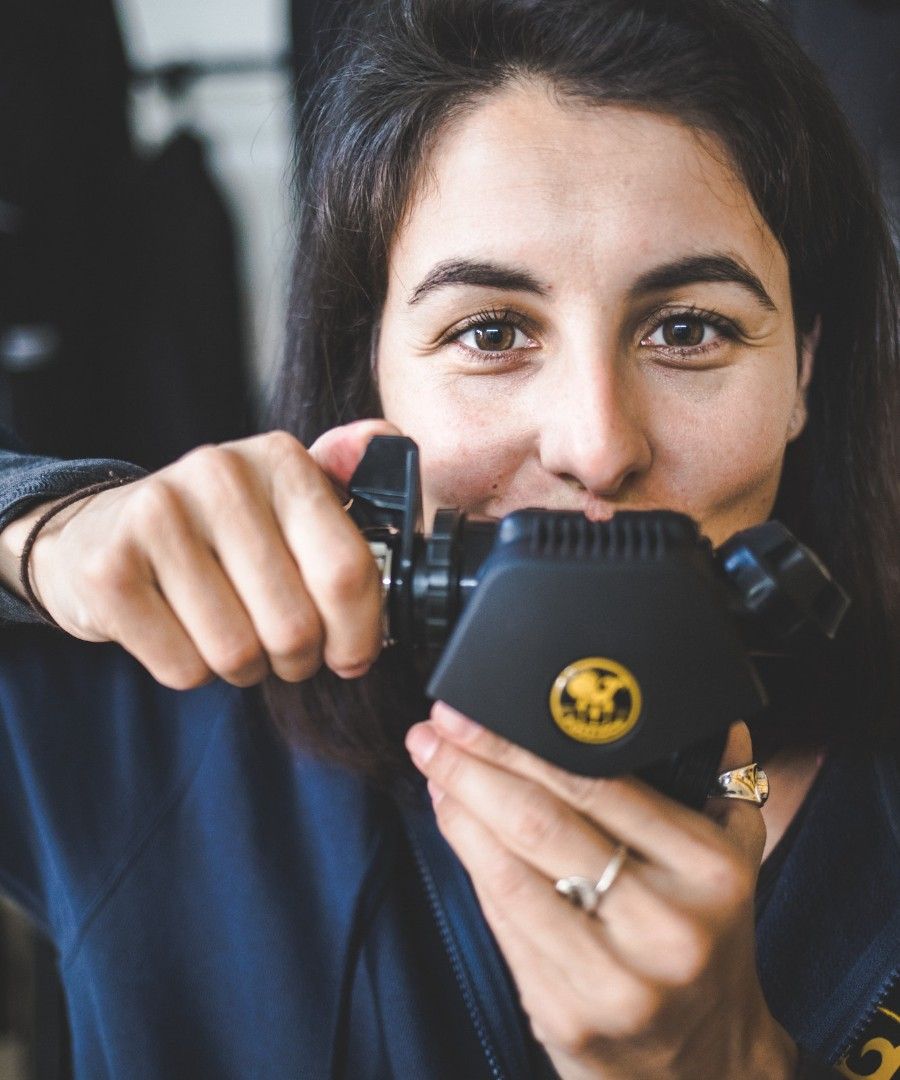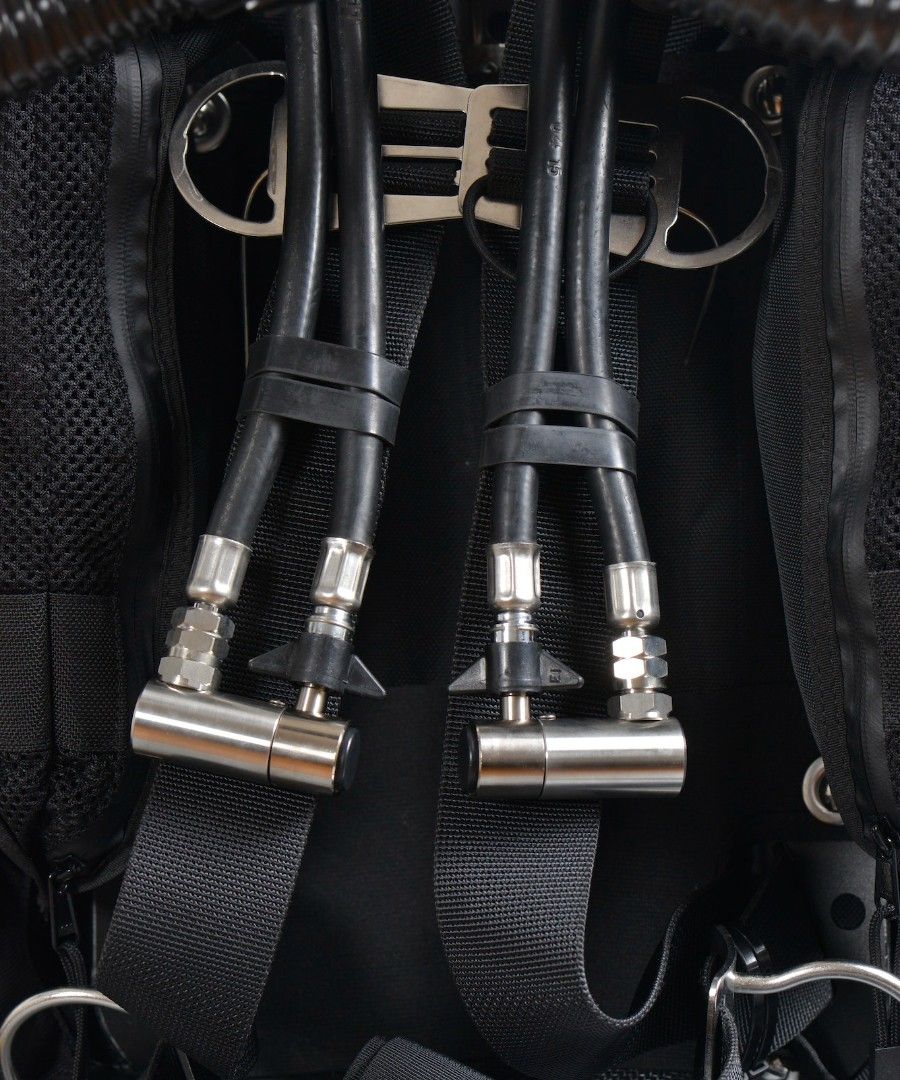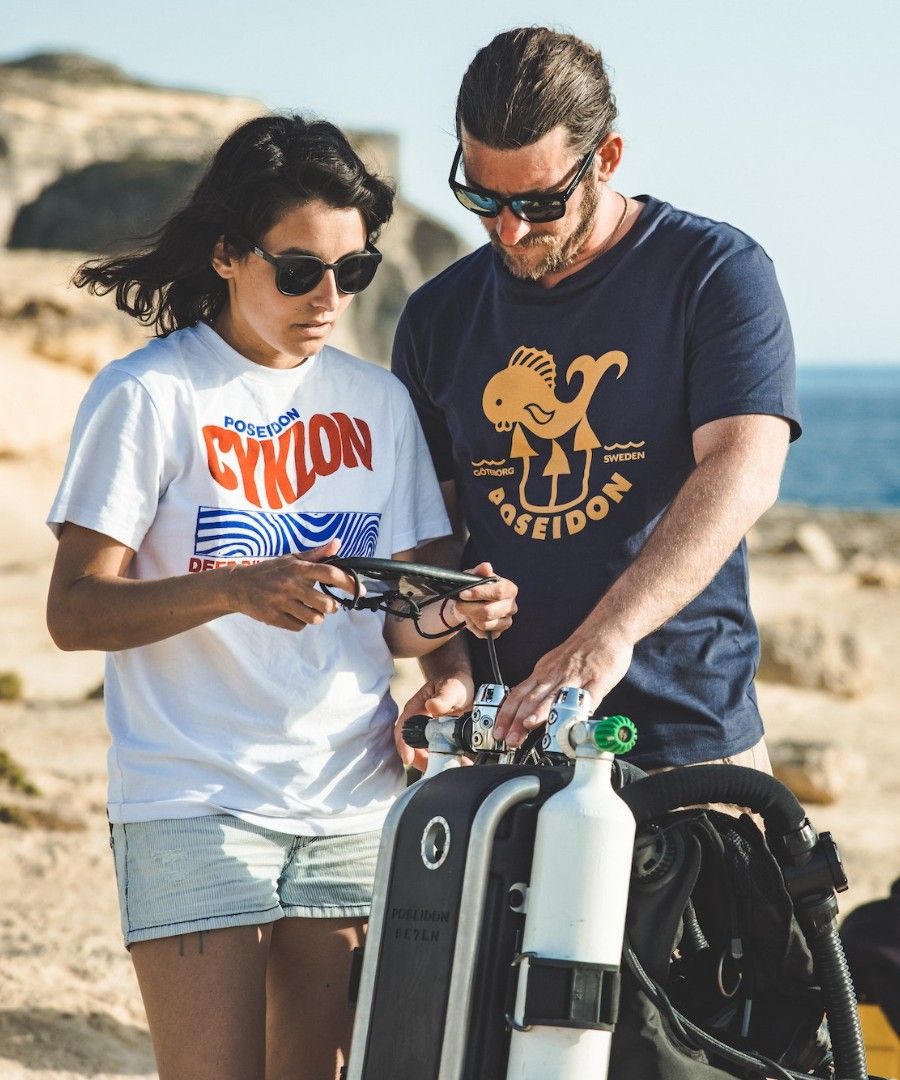
The basics.
Rebreathers may seem complicated, but the underlying idea is very simple; gas that would normaly be wasted as bubbles is instead re-used. Learn how a rebreather achieves this, what types there are and how the various components involved work.
A rebreather system circulates breathing gas around the diver allowing them to “re-breathe” their gas, instead of exhaling gas straight out into the water as in a scuba system. This makes rebreathers highly efficient as well as silent and bubble-free!
GET CLOSE TO MARINE LIFE
Rebreathers don’t create bubbles or noise, making you a natural part of the underwater environment.
EXPLORE UNDERWATER
Rebreathers use gas efficiently, allowing you to stay underwater for several hours, so you can take your time and enjoy the little (and big) things!
UNDERWATER PHOTOGRAPHY AND VIDEOGRAPHY
Marine life will come close for that great shot without distracting bubbles in the frame or bouyancy changes affecting your aim.
DIVE IN COMFORT
Rebreathers circulate warm, humid gas at ambient pressure, so it’s just like breathing above surface!
The principles.
O2 CCR, SCR, PSCR, mCCR and eCCR are all different principles of rebreathers. First, rebreathers come in either semi-closed circuit (SCR) where the air is regularly expelled as bubbles or closed circuit (CCR) where the air is continuously circulated. Below we explain the difference between the two principles.
SEMI-CLOSED CIRCUIT REBREATHERS
Semi-closed Rebreathers only use one gas cylinder with an enriched air content. It usually pushes gas into the loop with a constant flow. The oxymoronically named semi-closed rebreather isn’t as efficient as the closed circuit rebreather and will need to let the gas out from the system every other minute.
CLOSED CIRCUIT REBREATHERS
Closed circuit Rebreathers utilize two gas cylinders: one diluent tank (normal air, enriched air, trimix) and one oxygen tank. Oxygen can be injected manually (mCCR) or monitored and adjusted automatically with the help of a computer (eCCR). The closed circuit Rebreathers are much more efficient and quieter than the semi-closed system.

.jpg)
Rec or tec?
Unlike most rebreathers that must choose one or the other, Poseidon SE7EN+ has the ease of use and advanced safety systems needed for recreational diving while boasting performance and being configurable for expansion into uncompromised technical diving. Upgrades can be made in several stages so that you can choose the pace at which you learn to become a technical diver.
There are traditionally two types of rebreathers; recreational and technical. Recent technology breakthroughs have opened up rebreather diving to divers of all experience levels.
RECREATIONAL
Recreational rebreathers cater to the diver who appreciates less focus on the technical and physiological details and more on the experience. These are usually electronic rebreathers, enabling full automation of safety systems and gas composition which allows the recreational diver to enjoy longer and more comfortable dives than with a traditional scuba setup. Anyone can get certified to use a recreational rebreather thanks to the reduced number of tasks required for the diver to perform.
TECHNICAL
Technical rebreathers require special training in deep water and are suited for more advanced rebreather divers looking to graduate to the next level. These are usually manual rebreathers, which still monitor the partial loop pressure but the diver needs to add gases manually. As the diver gains more control over the gas content in the loop, possibilities open up for the technical rebreather diver to dive deeper and longer, but it also increases risk and requires significantly more skill and attention to maintain safety. The benefits of technical rebreather diving are huge when compared to technical diving on normal scuba diving equipment. The benefits include shorter decompression times, lower gas costs, and a better dive experience.
HOW SE7EN+ TECHNOLOGY WORKS
All closed-circuit rebreathers use oxygen, diluent (air/trimix), a breathing loop, counterlungs, a mouthpiece to deliver the breathing gas, a scrubber to remove the carbon dioxide from the system, and a method to replace the metabolized oxygen. That’s the easy part and where other rebreathers stop but Poseidon SE7EN+ technology really starts!
What makes the Poseidon SE7EN+ unique is the way in which it manages the gas in the breathing loop. The oxygen sensors detect the PPO2 in the breathing loop and solenoids automatically inject oxygen as required to maintain the appropriate PPO2 for the diver’s current depth. The SE7EN+ diver does not need to adjust PPO2 set points or manually maintain a set point; the SE7EN+ does it all for them.
The Poseidon SE7EN+ is an example of technology at its best; taking a complex process and making it beautifully simple. So simple, in fact, that the SE7EN+ diver can enjoy the dive!
Throughout the dive, Poseidon safety technology monitors the oxygen sensors to ensure they are working perfectly. Gas levels within the loop and the cylinders are monitored to ensure that the SE7EN+ diver has sufficient diluent gas available to reach the surface in the unlikely event of needing to "bail out" to open-circuit.
A three-level alarm system is there to alert the diver and buddy if something does not go according to plan. Alarms are delivered visually, by the wrist computer and the intelligent battery, audibly via the battery, and physically, via the mouthpiece that incorporates Juergensen Marine's DIVA vibrating alert technology.

how do i become a rebreather diver?
If you're looking for an adventure, you've come to the right place! Becoming a rebreather diver is fun, exciting and rewarding. Whether you’re an experienced diver or have never dived before, you can become a rebreather diver and open up an underwater world of endless adventure!
If you’ve never dived a rebreather before, you need to learn how by taking a Poseidon-approved rebreather training course, regardless of your dive experience. You can also do a Try Dive if you’d like to see if rebreathers are right for you before committing to a training course.
Get inspired and follow Sarah and Nico on their Poseidon SE7EN rebreather journey. From try dive and recreational courses to underwater photography and traveling with a rebreather.
Once you have successfully graduated from your course, you will be able to go diving under the same conditions and depths as the course, without the supervision of a dive instructor.
All the major dive training agencies have courses that will teach you how to become a proficient, safe, and happy Poseidon Rebreather Diver. Whichever agency you choose, the courses are generally separated into three sections; theory, practical and diving.
rebreather components
What are the parts of a rebreather and how do they work?
the breathing loop
In CCRs the gas that the diver breathes is circulated in a loop. There are many aspects of the loop to consider. Most importantly, the gas must have the correct composition for the specific depth that the diver is at. Oxygen must be replenished and carbon dioxide must be scrubbed.
The loop must also have enough gas for the diver to be able to take a full and comfortable breath. This is achieved by including counter lungs that work as reservoirs for both the inhalation and exhalation of air.
Counterlungs
Human lung volume is generally about 5-8 liters, and when you dive a rebreather this volume of gas needs to be collected somewhere. Therefore, a rebreather has counterlungs that collect the gas that you exhale. Normally a rebreather has two sets of counterlungs: an inhalation side and an exhalation side.
Overpressure valve
The Over Pressure Valve (OPV) is used for adjusting the lung volume. It automatically lets expandable gas out upon ascending and should be adjusted to reach what is called the minimum lung. The OPV could also be used to drain the loop of water.
Water diversion manifold
The water diversion manifold is located on the breathing loop and is designed to prevent water from entering the counterlungs and reaching the scrubber.
Canister housing
The canister housing sits on the diver’s back in most cases and protects the scrubber. The e-module is usually mounted on top of the canister housing.
Scrubber
The scrubber is a soda-lime-based product that is designed to deduct carbon dioxide from the gas that passes through. When a scrubber is being used in a rebreather, it is integrated into the loop. It will then absorb the CO2 in the gas that is produced by the diver. This process is called “scrubbing” amongst rebreather divers.
E-module
The e-module contains the controlling computers, oxygen sensors, and solenoids. This is where the oxygen content of the loop gets analyzed. If needed, oxygen is added into the loop.
Oxygen sensors
The most important thing when it comes to rebreather diving, except for breathing continuously, is to always know what gas you are breathing. For this reason, you will need oxygen sensors in the loop to analyze the gas that passes through. Depending on what type of rebreather you are using, you will add oxygen manually (technical rebreather) or the machine will add oxygen automatically (technical and recreational rebreather) to make sure that the fraction of oxygen is correct in the loop.
Solenoids
Solenoids or pneumatic solenoids, sit at the end of a low-pressure hose from either the diluent or oxygen cylinder. When the rebreather or the diver detects that the machine needs either more oxygen or diluent in the loop the solenoid is activated. When the solenoid is activated it will inject the respective gas into the loop in small bursts. Whether the diver manually or the rebreather automatically triggers the solenoids depends on if the rebreather is a recreational or technical machine.
Battery
The battery or batteries will provide the power for the computer or computers. Different manufacturers use different types of batteries. Some use normal AA batteries and others, like the SE7EN+, use smart batteries. Poseidon Smart Batteries come in two different versions that let you get access to different depths by enabling deco-mode and Trimix diving.
Display/Computer
All rebreathers use a display or computer of some sort. Some use an external computer, which the diver will need to purchase themselves and add to the rebreather configuration. Other rebreathers have a display and computer built into the system from the start, like the SE7EN+. The display or computer will show the diver all of the important data they will need to know during the dive and on land.
Mouthpiece
A rebreather mouthpiece connects the diver to the rebreather, so he/she can breathe from the loop.
Head-up display
The head-up display (HUD) sits on top of or is integrated into the mouthpiece. The HUD will show the diver that the system is functioning properly or if there are any warnings to be aware of. On the SE7EN+ the HUD is integrated into the mouthpiece.
Bailout valve
The bailout valve (BOV) is either attached or integrated into the mouthpiece. When the diver needs to go off or on the loop he/she activates the BOV. The reason for bailing out from the loop is mainly that you have an “un-breathable loop”. Once bailed out the diver will exhale straight out into the water like a normal open-circuit diver. On the SE7EN+ the BOV is integrated into the mouthpiece.
Automatic Diluent Valve
When a diver descends, the gas in the loop will be compressed as pressure increases from the surrounding water. After a couple of meters/feet, the gas will be so compressed that the diver won’t have enough gas in the loop to take one full breath. This is when the Automatic Diluent Valve (ADV) is activated and makes sure that the diver gets enough additional gas from the diluent cylinder, which is injected directly into the loop. The ADV can be placed in different locations: on a t-valve, counterlung, or on/in the mouthpiece. On the SE7EN+ it is placed inside the mouthpiece.
One-way valves
To make sure that the gas in the loop travels in the right direction, a rebreather utilizes one-way valves or mushroom valves. This will prevent the air from simply going back and forth in the loop, and it will instead be channeled around the diver; in through the scrubber and past the oxygen sensors.
Oxygen & Diluent Cylinder
The oxygen and diluent cylinders are placed on each side of the canister housing. The oxygen cylinder is primarily used for the diver's metabolism rate and contains 100% oxygen. The diluent cylinder is used for compensating the decreased loop volume upon descent and filling up your buoyancy devices. The Diluent contains normal air in most cases and if you are a technical diver the diluent contains different types of gas mixtures of Trimix.
regulators
The first stage regulators make sure to decrease the pressure of the cylinder to an intermediate pressure that will go to the solenoids for the distribution into the loop. The diluent gas will also be directed to the mouthpiece if the loop doesn’t contain enough air for a single breath. Then the diluent gas will be added into the loop automatically through the ADV.
Bailout cylinder
As soon as you are planning a dive below 18 meters /60 feet most dive agencies say that you should carry a bailout cylinder. A dive down to 30 meters / 100 feet is sufficient with a 5 liter / 40 cu ft bailout cylinder if the diver is not going to do a decompression stop.
Technical divers need to consider a lot of different scenarios when it comes to reaching the surface in a safe manner if they need to bailout from the loop. They would need several bailout cylinders with different gas mixtures to safely make it to the surface.
#DIVEposeidon
Share your pictures and inspire others. Don't forget to tag your pictures with #diveposeidon | @poseidondivingsystems






